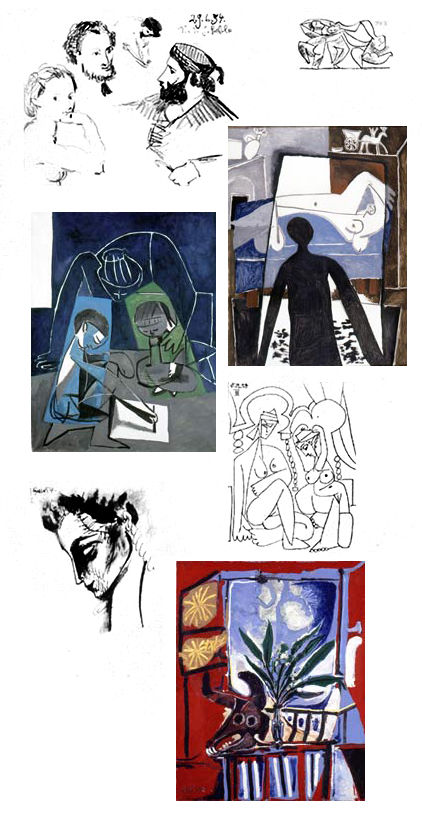70 years old
1951: -Picasso and Françoise visit Matisse whose Chapel in Vence is inaugurated.
-Picasso is forced to leave his apartment and studio rue de la Boétie.
-The whole family moves into rue Gay-Lussac in Paris.
-“Face of Peace”, last collaboration of Eluard and Picasso.
-Birth of Paul’s second child: Marina
Rue de la Boétie
In 1918, having just married Olga,
Picasso, aged 37, moves close to
his dealer Rosenberg, rue de la
Boétie, where he occupies two floors:
a studio and a flat. He remains there
until 1937. It is in the same street, but
at number 44, that he will shelter his
secret liaison with Marie-Thérèse in 1930.
1952: -Starts project for the Vallauris Chapel (later Temple of Peace) with two panels “War and Peace”
-November 18: Paul Eluard dies.
-Picasso completes his second play “Les Quatre Petite Filles” started in 1947.
-D-H Kahnweiler publishes “Huit entretiens avec Picasso” followed the year after by “Picasso et le Cubisme”.
-First encounter with Jacqueline Roque.
Jacqueline Roque
"Femme à la fraise et au chapeau" 1963
1953: -“Les Demoiselles d’Avignon” are shown for the first time since 1916 at the Musée National d’Art Moderne in Paris”
-Scandal at the French Communist Party against Picasso: his portrait of Stalin published at the occasion of his deaths judged not conform to Communist orthodoxy.
-Stay in Perpignan.
-Françoise leaves Picasso and takes the children to Paris with her.
-Travelling retrospective in Rome and Milan.
-The town of Barcelona buys the Aguilar Palace, future location of the Picasso.
1954: -The works “War and Peace” are placed in the Vallaurice Chapel.
-Jacqueline Roque becomes his last companion 1st linocut.
-November 3: Death of Matisse
-Décor for Garcia Loca’s “Chant Funèbre”.
1955: -His wife Olga dies on February 11.
-Retrospective at the Musée des Art Décoratifs in Paris in which Guernica is shown.
-Show then travels to Munich, Cologne, and Hamburg.
-He buys a very large house in Cannes. La Villa Californie. Its architecture will appear in many drawing over the following years.
-Very near, in studios in Nice, Henri-Georges Clouzot films “Le Mystère Picasso”.
-Begins work with Norwegian sculptor Carl Nesjar to make concrete sculptures from drawing by Picasso.
Cannes
As for Juan-Les-Pins, Antibes, Vallauris or Mougins, where he spends many summers from the 1920s, Picasso knows Cannes well before moving into the famous studio-house with a pseudo-Moorish architecture called La Villa Californie in 1955.
1956: -Picasso and other intellectuals write a letter to the Communist party condemning the Soviet intervention in Hungary.
1957: -Carl Nesjar makes the first concrete sculptures from Picasso’s drawings for an official building in Oslo.
-Beginning of sheet-metal sculptures.
1958: -Large mural “The Fall of Icarus” placed in UNESCO headquarters in Paris.
-New home, new studio, in the chateau de Vauvenargues below the Saint-Victoire, an emblematic place of Cezanne.
-His sister Dolores called Lola, dies.
Vauvenargues
Aged 77, Picasso buys a life-size
Cézanne: the Montagne
Sainte-Victoire can be seen from
the windows of the Château de
Vauvenargues in which he vainly
attempts to live and work during
three years. He leaves this overwhelming greatness
as early as 1961.
1959 :
- New exploration of linocut with « Portrait of a Girl after Cranach ».
- Makes many linocuts.
- The bronze « Head of Dora Maar » is finally chosen as monument to Apollinaire and placed in square of Saint-Germain-des-Prés in Paris.
- Beginning variations on Manet’s “Luncheon on the Grass”.
- Inauguration of Vallauris Chapel decorated with “War and Peace”.
- Works on Cocteau’s film “Le Testament d’Orphée”
- Birth of Paul’s second and last son: Bernard.
1960 :
- Major retrospective at the Tate Gallery.
- Drop curtain for serge Lifar’s “L’Après-midi d’un faune (after Nijinsky)





 Summary
Summary